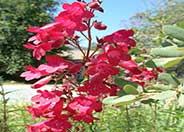
Common name:Spanish Lavender
Botanical name:Lavandula stoechas
This dense shrub grows 2'-3' tall with blue gray foliage and deep purple flowers that have large showy bracts near the top of the spikes. It is drought tolerant . - Cornflower Farms

Common name:Double Sunburst Coreopsis
Botanical name:Coreopsis grandiflora 'Double Sunburst'
The 'Double Sunburst' is a wonderful cultivar and a showy, Southern U.S. native. Golden yellow, double flowers on 2' bushy plants bloom from June to September in full sun and average to dry soils. It makes for good cut flowers, and pruning keeps the plants abundant with blooms. -Holland WIldflower Farm

Common name:California Sycamore
Botanical name:Platanus racemosa
The California Sycamore is a fast growing deciduous tree that reaches up to 40'-50' high. It tolerates heat, smog, and drought conditions as well as moist conditions; it is native to riparian areas. It has interesting mottled bark when the tree is bare in winter.

Common name:Ruby King Penstemon
Botanical name:Penstemon hybrids 'Ruby King'
Penstemon 'Ruby King' has tubular flowers. Hummingbirds are attracted to the flowers. It needs fast drainage. It is usually short lived (3-4 years).

Common name:Eastern Redbud
Botanical name:Cercis canadensis
This small, deciduous tree with a rounded head is covered with small flowers of a rose pink color in the spring before the appearance of heart-shaped leaves. It can grow to 25' tall with an equal spread. It has a low branching habit with a rounded form. Leaves turn yellow green in the fall.

Common name:Santa Ana Cardinal Coral Bells
Botanical name:Heuchera 'Santa Ana Cardinal'
This Heuchera is believed to be a hybrid between the native Heuchera maxima and the non-native Heuchera sanguinea. The name is a little misleading as the flower is more pinkish red than it is red or cardinal. It is best used in dry shady conditions with well drained soil. Once established, it requires little care. It is susceptible to mealy bugs and root rot if it receives too much water. It grows to 18"-24" tall and wide. It looks great in mass plantings.
The Magic of Mulch
In the natural world the endless cycle of birth, growth, decay, death and rebirth flows throughout the seasons. Plants die, leaves fall and new growth springs up in its place. Nothing is lost and the fallen leaves and dead plants decay into the soil, enriching it for the next generation of growth.
Click in the green box for more information
| Designer: | Integration of Boulders |
Photographer: GardenSoft |
Soils and Compost:
Physical weed control, including mulching, or hand removal protects the watershed from harmful chemicals.
Water Saving Tip:
Adjust sprinklers to avoid watering sidewalks and driveways.
Integrated Pest Management:
Remove irrigation water and fertilizer from areas where you don't want weeds to grow.

